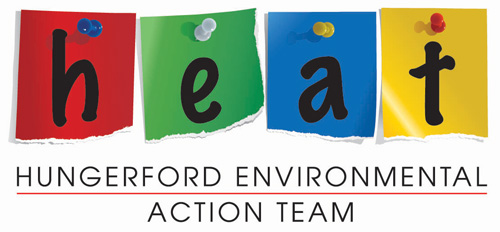 |

|
| Home | Setting the Scene | Useful Links | Contact Us | | |
|
Statement of Community Intent Energy Carbon Footprint Transport Food Allotments Education & Employment Landscape & Biodiversity Waste Marketing Whatson Living Lightly Green Exchange |
1. Introduction 1.1 This note aims to clarify the process followed to involve the community in reducing Hungerford’s impacts on climate change. This report presents a structured and thorough approach to marketing the message and influencing behaviour. 2. Aim of HEAT 2.1 The aim of HEAT is: To reduce the impact of the Hungerford area on climate change 2.2 Preliminary targets set to achieve this are: 1) To reduce CO 2 emissions of the Hungerford area by 20% by 2011. 2) To reduce CO 2 emissions of the Hungerford area by 50% by 2016. 3. General Approach 3.1 HEAT is developing a partnership approach. It is in the process of engaging all groups and agencies that wish to input to the process. All groups need to feel that they are part of the partnership and that they can influence the outcomes. Figure 1 shows the structure of the partnership with all the main groups and organisations involved. 3.2 The key aim of the approach is: To make the partnership inclusive 4. The Methods 4.1 There are 8 main methods being proposed as follows:
3.2 Table 1 (on spreadsheet file) shows how the methods will be used for the different groups identified. It also shows where, old, young or special groups are targeted. Figure 2 shows diagrammatically, the proposed eight methods of involving the community. Some a directed by the type of group, as the schools, but most involve a range of groups. 3.3 Careful consideration is required on the balance of use of the seven different methods. For example it may be possible to have a survey of every household, instead of more indirect approaches through community groups or schools. The particular advantage of community groups is:
4. The HEAT Group & Working Groups (Method 1) 4.1 The HEAT group was set up following the annual public meeting in the Town Hall in April 2007. The Steering Group is evolving and currently is proposed with two persons per working group who meet about once a month. It also includes input from Marlborough and Lambourn climate change groups 4.3 Those attending the early HEAT meetings were those who had expressed an interest in becoming involved and helping with the process of reducing our effects on global warming. 4.4 The primary role of the HEAT Steering Group is to provide guidance and support and specifically:
ENERGY: Its many uses, conservation and generation and inputs to most other groups. FOOD: Becoming more locally self sufficient and reducing food miles. TRANSPORT: Closely linked to Energy, Food and Employment. EDUCATION & Is there an appropriate balance at locallevel EMPLOYMENT: Encouraging appropriate skills and contacting businesses. LANDSCAPE & Recognising the importance of bio-diversity and BIO-DIVERSITY: its link with our landscape. WASTE: Its reduction, re-cycling and disposal. MARKETING: Promoting HEAT’s activities, spreading the word and reporting its progress. 5. Community Forums & Markets (Method 2) 5.1 There is not a single format for these and they have been categorised into three main types:
5.2 Room Presentations: So far there has been a showing of the film ‘An Inconvenient Truth’, which was well attended. Other films and a projector are available for small groups. 5.3 Sunday Farmers Market: The food group have been active in having a stall at the farmers market. They have recently introduced a seasonal food feature which has generated much interest. This is proving to be an effective way to get HEAT’s message across and gain new members.
5.4 Linking with other forums: The annual Parish meeting every March will have a brief input from HEAT which is normally a well attended meeting. It was at the Parish meeting of 2007 that the HEAT group was launched. 6. Schools (Method 3) 6.1 There are three main schools in Hungerford, all of which will be contacted and invited into the partnership. They are:
6.2 Preliminary discussions have already taken place with the youth council. 6.3 This will provide essential connections with school age children in Hungerford. 7. Businesses (Method 4) 7.1 Businesses are major generators of green house gases. Links are being established with the Chamber of Commerce and key employers.
8. Talking with Community and Neighbour Groups (Method 5) 8.1 Each of Hungerford’s main community groups will be approached. These include the scouts, St Johns Ambulance, Youth Club, the Town & Manor, medical practices and churches. They will be given an informal presentation and asked to comment and be involved in the partnership process. There will be handouts to all attending to invite comments. 8.2 The HEAT group is also talking with neighbouring environmental groups. Notably the Lambourn Valley Group are actively assisting us. We also have input from Marlborough and links with Newbury and Thatcham Transition Towns . Transition West Berkshire is evolving as a group and HEAT will need to consider the extent of association with this group. 9. Questionnaires (Method 6) 9.1 Questionnaires will be carefully considered. At this stage it is proposed to do the following:
9.2 Data entry and monitoring issues are important and are still to be resolved. 10. Web Site (Method 7) 10.1 The Hungerford web site (www.hungerford.co.uk) which has a section on HEAT already, but needs expanding. This explains what is being done and what progress has been made. It also includes a forum section so comments on visions or thoughts about the plan can be put forward. 11. Newspaper (Method 8) 11.1 The local newspapers have expressed an interest in placing coverage of HEAT and the Newbury Weekly News has already helped with information. A quarter page could be an effective method of generating interest and comment. 12. Comments Tracking Database 12.1 A database will be set up to track all comments made. The main fields will include:
Ref: HEATCominvolve1a
|

